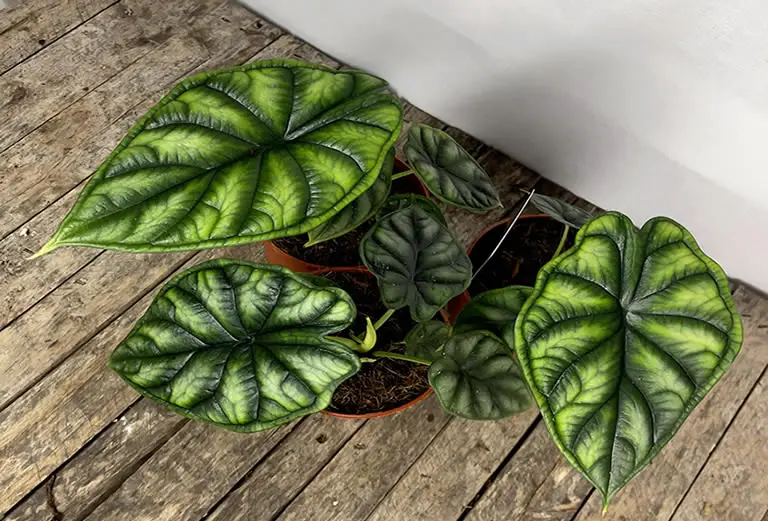With its armored, jewel-toned leaves, the Alocasia Dragon Scale looks like something straight from a fantasy novel. This unique plant doesn’t just add drama to your indoor jungle—it demands attention.
While it may not be the easiest houseplant on the shelf, with the right care, it’ll reward you with stunning foliage that feels more like sculpture than greenery.
Let’s dig into everything you need to know to care for your Alocasia Dragon Scale and keep it looking magical all year round.
Table of Contents
- What Makes Alocasia Dragon Scale So Special?
- Best Light Conditions for Alocasia Dragon Scale
- How to Water Your Dragon Scale Without Overdoing It
- Creating the Ideal Soil Mix
- Humidity Needs: Think Jungle-Like Conditions
- Temperature Tips to Prevent Dormancy
- Fertilizing Without Overdoing It
- What to Know About Its Modest Blooms
- Simple Pruning for Health and Appearance
- Dormancy: Why It Happens and What to Do
- Repotting: Only When Truly Necessary
- Propagation by Division: Easy but Delicate
- Toxicity Warning: Keep Away from Pets and Kids
- Pests to Watch For
- Common Diseases: Mostly Moisture-Related
- Quick Care Summary
- Final Thoughts: Worth the Extra Effort
What Makes Alocasia Dragon Scale So Special?
Alocasia Dragon Scale (Alocasia baginda ‘Dragon Scale’) is a tropical beauty native to Borneo.
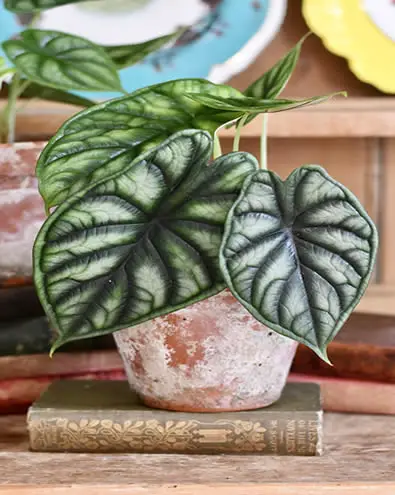
It belongs to a group of highly sought-after plants called “jewel Alocasias,” which are known for their compact size and show-stopping foliage.
The leathery, metallic-looking leaves are pale silvery green with deep, dramatic veining.
The reverse side of each leaf is a creamy white with bold maroon veins.
Even young plants bring serious style, making this a popular pick for collectors and terrarium fans alike.
Best Light Conditions for Alocasia Dragon Scale
Bright, indirect light is perfect for this plant.
Direct sun will burn the leaves, while low light will cause slow, leggy growth.
Keep your Dragon Scale a few feet back from a bright window or use sheer curtains to filter the light.
Tips for lighting:
-
Rotate the pot a quarter-turn each time you water to keep growth even
-
A north or east-facing window is ideal
-
Grow lights work great if natural light is limited
-
Outdoors, only keep it in full shade or dappled light
How to Water Your Dragon Scale Without Overdoing It
This plant likes evenly moist soil—but it absolutely hates soggy feet.
Let the top 2–3 inches of soil dry out between waterings.
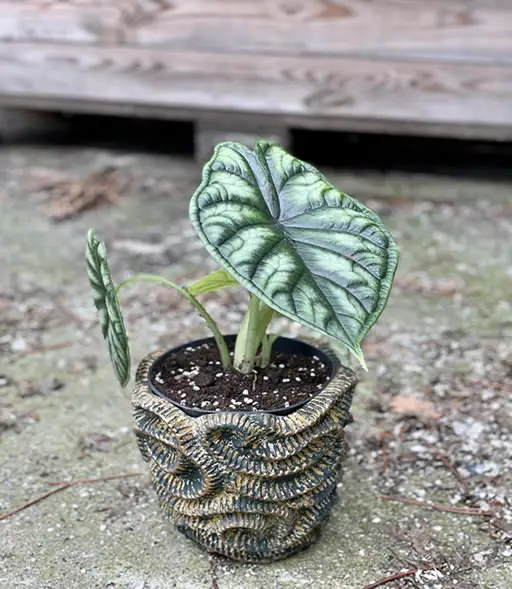
When it’s time to water, give the plant a deep soak and let excess water drain away.
Important watering tips:
-
Avoid splashing water on the leaves
-
Never let the soil stay saturated
-
Use lukewarm, filtered water if your tap has fluoride or high mineral content
-
During dormancy, reduce watering significantly
Think of it as a semi-succulent in terms of how carefully you’ll want to manage soil moisture.
Creating the Ideal Soil Mix
Good soil is non-negotiable with this plant. The roots need a mix that’s chunky, breathable, and drains quickly.
Try this soil blend:
-
1 part perlite
-
1 part orchid bark or mix
-
1 part chopped coco coir or peat moss
Add compost or worm castings (up to 10%) if you’d like a little nutrient boost.
Avoid heavy or compact soil—it traps moisture and leads to root rot fast.
Humidity Needs: Think Jungle-Like Conditions
Alocasia Dragon Scale loves high humidity. It’ll tolerate 40–50% in a pinch, but it thrives at 60% or higher.
Dry air causes brown tips, crispy edges, and stress that makes the plant vulnerable to pests.
How to boost humidity:
-
Run a humidifier nearby (especially in winter)
-
Group it with other tropical plants
-
Use a pebble tray or relocate to a naturally humid room like a bathroom
-
Keep air moving gently to avoid fungal problems
A digital hygrometer helps you monitor conditions so you know when to take action.
Temperature Tips to Prevent Dormancy
This Alocasia prefers warm, stable temperatures between 55°F and 80°F (13–27°C).
Sudden drafts or exposure to cold can shock the plant and trigger dormancy.
Watch for these signs of stress:
-
Yellowing leaves
-
Leaf loss or slowed growth
-
Drooping despite proper watering
In cooler months, your plant may go dormant. If it does, reduce watering, keep it warm, and wait.
Don’t toss it—it’ll likely bounce back in spring.
Fertilizing Without Overdoing It
Feed lightly but consistently.
A balanced liquid fertilizer diluted to half strength every six weeks during the growing season is plenty.
Skip feeding in fall and winter when growth slows or stops.
Pro tips:
-
Flush the soil every few months to remove fertilizer buildup
-
If you notice brown tips, it may be due to overfeeding
-
Organic options like worm tea or fish emulsion are gentle alternatives
What to Know About Its Modest Blooms
Dragon Scale might flower, but the tiny purple spathes are hardly noticeable next to those dramatic leaves.
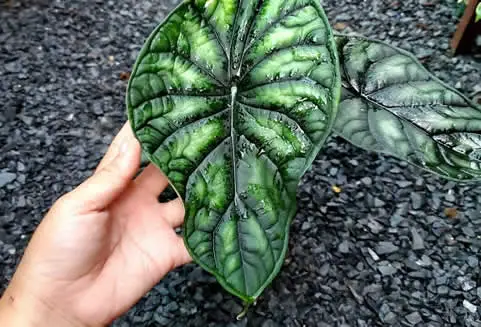
Many growers prune blooms early to conserve the plant’s energy.
It’s optional, but removing spent flowers can help maintain plant health.
Simple Pruning for Health and Appearance
This is a low-maintenance plant when it comes to pruning.
Just remove dead or damaged leaves at the base using sterilized scissors or pruning shears.
Clearing away dead plant matter helps prevent disease and keeps things looking clean.
Dormancy: Why It Happens and What to Do
Alocasia Dragon Scale may enter dormancy when light or temperatures drop.
During this time, it can lose most of its leaves and stop growing completely.
What to do:
-
Don’t overwater during dormancy—let the soil almost fully dry
-
Place it in a moderate light and warm spot
-
Wait patiently for signs of new growth in spring
The plant stores energy in its underground tuber, so even if all leaves disappear, it isn’t dead.
Repotting: Only When Truly Necessary
Repot only when your plant has clearly outgrown its container—every 2–3 years at most.
Dragon Scale doesn’t like having its roots disturbed and may sulk or drop leaves after a move.
Repotting tips:
-
Do it in spring when the plant is actively growing
-
Choose a pot only 1–2 inches wider
-
Avoid overpotting, which can lead to excess soil moisture and rot
Propagation by Division: Easy but Delicate
Alocasia Dragon Scale can be propagated by dividing its tubers during repotting.
Step-by-step:
-
Gently remove the plant from its pot
-
Shake or rinse off soil to expose roots
-
Separate offsets or tubers using your hands or sterile tools
-
Plant each division in a small container with well-draining soil
-
Provide warmth, humidity, and indirect light
-
Water lightly and monitor for signs of rot or new growth
Optional: Covering divisions with a clear dome or plastic bag can help maintain humidity.
Toxicity Warning: Keep Away from Pets and Kids
Like other Alocasias, Dragon Scale contains calcium oxalate crystals, which can cause severe irritation if ingested.
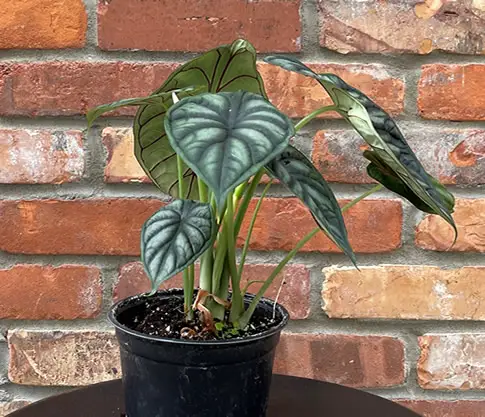
It can also cause skin reactions.
Always wash your hands after handling and keep the plant safely out of reach.
Pests to Watch For
This plant isn’t a pest magnet, but its tender foliage can attract:
-
Spider mites (look for webbing)
-
Mealybugs
-
Aphids
-
Scale insects
Prevention tips:
-
Spray regularly with diluted soapy water or neem oil
-
Keep humidity high to deter spider mites
-
Inspect new leaves and underleaf areas weekly
Treat infestations early and isolate infected plants immediately.
Common Diseases: Mostly Moisture-Related
Leaf spot diseases and fungal infections are the most common issues, often caused by excess water or poor airflow.
Avoid misting the plant directly and don’t let leaves stay wet for long periods.
Isolate the plant if you notice spots, trim affected areas, and improve airflow and watering habits to prevent recurrence.
Quick Care Summary
-
Light: Bright, indirect
-
Water: Let top 2–3″ dry between watering
-
Humidity: 60–80% preferred
-
Temperature: 55–80°F (13–27°C)
-
Soil: Chunky, fast-draining mix
-
Fertilizer: Half-strength every 6 weeks in growing season
-
Toxicity: High—handle with care
Final Thoughts: Worth the Extra Effort
Alocasia Dragon Scale isn’t the easiest houseplant, but it’s one of the most visually rewarding.
With the right combination of light, humidity, and patience, you’ll be rewarded with foliage that looks more like fine art than greenery.
Whether you’re building a terrarium or curating a bold plant shelf, this is one jewel you’ll be glad to polish.
Related Articles
You may be interested in these other articles about Alocasia care:
Alocasia Plant Care: Indoor & Outdoor Care Guide
Alocasia Water Guide. Watering Alocasia & Growing Alocasia In Water
Understanding Alocasia Dormancy: What It Is, Why It Happens, and How to Handle It
How to Keep Your Alocasia Wentii Thriving: Complete Care Guide
Why Are My Alocasia Leaves Turning Yellow? Causes, Fixes, and What to Do Next
Why Is My Alocasia Drooping? Common Causes and How to Revive It

